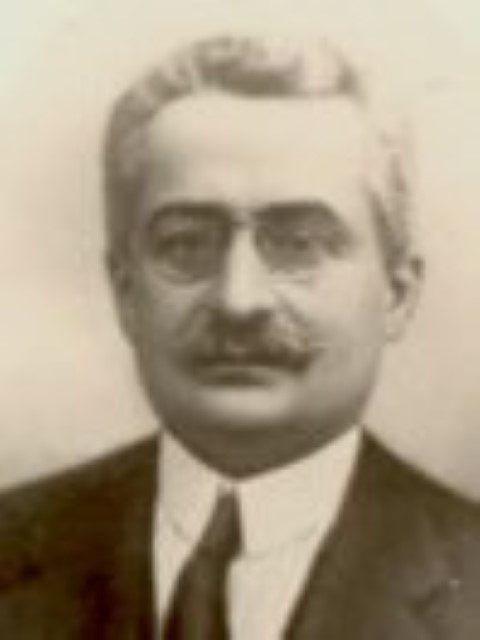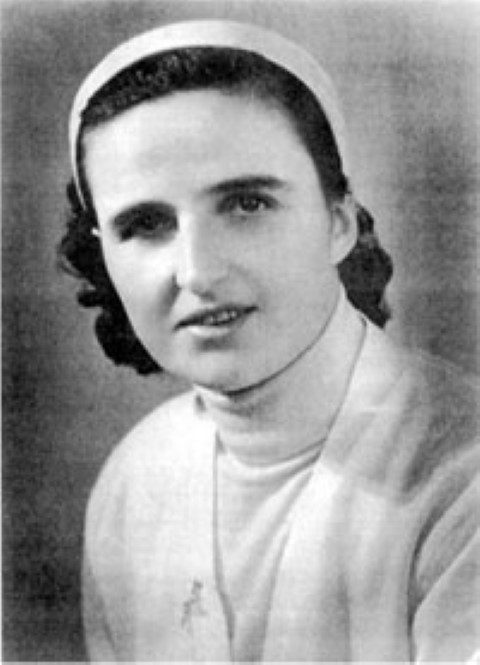María Belén Eyheramonho
Buenos Aires, Argentina
While thinking of medicine as an honorable profession and of the patient-doctor relationship under the light of the human dignity of every person, three legendary figures come to mind: Dr. Giuseppe Moscati, Dr. Gianna Beretta Molla, and Dr. Jérôme Lejeune. Throughout this essay, as I present a short biographical review for each of them, I invite the reader to contemplate and be amazed by these emblematic heroes, whose lives are an intriguing invitation to reconsider the goals and motivations of our professional work.
 |
| Dr. Giuseppe Moscati (1880–1927) |
Giuseppe Moscati (1880–1927), also known as the “Doctor to the Poor”1 was a young physician and researcher who graduated summa cum laude from the University of Naples on April 1903. He dreamed of a solidarity-based society, and though he had the opportunity to achieve prestigious positions as a professor, he preferred to consecrate himself to the hard work of caring for the sick at the hospital.
When Mt. Vesuvius erupted in April 1906, Dr. Moscati risked his own life to rescue the patients trapped in Torre del Greco, which he successfully achieved just before the building collapsed.2 If wondering what motivated him to act in that way, we can find the answer in one of his letters to a colleague, where we read: “Not science but charity has transformed the world in some periods, and only very few men became famous because of their science; but all men will be everlasting, as a symbol of the eternity of life, in which Death is only a stage, a metamorphosis to a higher place, if they will devote themselves to Good.”3 Obviously, what he wrote were not just empty words, but evidence of true conviction; he led the example in living out charity and devoting himself to do what is good.
But Dr. Moscati did not underestimate the medical sciences. On the contrary, he made an enormous commitment to it, which led him to always put his patients first: “Remember that, following Medicine, you undertook upon yourself the responsibility of teachings always in your memory, with love and pity for the abandoned, with faith and enthusiasm, deaf to praises and criticisms, to envy, inclined only to God.”4
In his gigantic generosity, he served the needy right until the moment of his death. On April 12th 1927, despite not feeling well, he examined his patients and soon after quietly died in his armchair. Everybody grieved upon his death and he was buried in the Cemetery of Poggioreale, leaving after him a legacy of honor.5
 |
| Dr. Gianna Beretta Molla (1922–1962) |
Gianna Beretta Molla (1922–1962)6 was a wife, mother, and physician in a time when it was not popular for women to occupy positions in universities. This Italian lady grasped the urgency of spending her life helping the needy and during her years as a student volunteered to help the youth, the elderly, and the poor. Later, after receiving her degree, young mothers would find in her office warm support along with high professional excellence. She once thought of becoming a missionary doctor but instead fell in love and married Pietro Molla, an engineer with whom she was happily married with four children.
But when it comes to suffering, doctors are not an exception to the rule. When she was thirty-nine and pregnant with her fourth child, they found a serous fibroid in her uterus. The indication was a laparotomy, but she wanted her child’s life protected, if necessary, above her own life. Therefore, instead of practicing a total extirpation, which was a common procedure for such cases, the surgeon extirpated only the fibroid. Without damaging the uterine cavity, this allowed her to continue with her pregnancy. She had clearly stated: “I’m ready for anything, as long as I save my baby.”7
Despite her suffering, she was happy because after the surgery she could continue her pregnancy. However she died months later, a few days after delivery, because as a doctor she knew her own life was the greater gift she could give as a mother. Thirty years later her daughter would see her mother proclaimed as a hero for surrendering generously her life to save her child.
 |
| Dr. Jérôme Lejeune (1926–1994)
|
Jérôme Lejeune (1926–1994)8 was a world-renowned French geneticist, who raised his voice to defend the dignity of the human being from the first moment of conception. He discovered the first human disease due to a chromosomal error, Down syndrome. It was as recognition for this discovery that he received the Kennedy Prize in 1962 from the hands of President John F. Kennedy, and in 1969 the William Allen Memorial Award from the American Society of Human Genetics.
“Hate the disease, love the patient: That is the practice of medicine,”9 he would state. As a pediatrician and geneticist, he was devoted to his patients with mental illnesses. He would call them “dear little ones” and would tell their parents that their kids possessed special gifts of love and affection. To those worried about economic interests more than about human dignity, he would argue: “It cannot be denied that the price of these diseases is high—in suffering for the individual and in burdens for society. Not to mention what parents suffer! But we can assign a value to that price: It is precisely what a society must pay to remain fully human.”10
He knew how to combine his wisdom with a smart irony. It is interesting to understand his reasoning about the devastating consequences for humanity derived from eugenics. He noted that among all the cultural treasures we have received from ancient Greece, still we could not cherish any precious inheritance from a particular city, Sparta:
To avoid overheating the debate, I will go much further back—to the Spartans, the only ones to eliminate newborns that they believed would be unable to bear arms or beget future soldiers. Sparta was the only Greek city to practice this kind of eugenics, this systematic elimination. And nothing remains of it: It has left us not a single poet, not a single musician, not even a ruin! Sparta is the only Greek city that contributed nothing to humanity! Is that a coincidence or is there a direct connection? Geneticists wonder, “Did they turn stupid because they killed their future thinkers and artists when they killed their less-than-beautiful children?”11
But what is “it” that makes a human being to be such, and not something different? In 1989, Dr. Lejeune was required to declare as a witness for an unusual trial: a lawsuit between a former husband and wife about who should have the custody of seven frozen embryos they had saved in a fertility clinic before their divorce. Dr. Lejeune, after referring to cryotubes as “concentration pots” in analogy with concentration camps, explained to the magistrate what defines a human being:
With respect to your nature, I can’t see any difference between the early human being you were and the late human being that you are now, because in both cases you were and are a member of our species. What defines a human being is this: It belongs to our species.12
During the same trial, he explained how the embryo is the natural result of conception, through the union of one egg and one sperm. However, if the conception instead involves nuclei from two sperms, meaning that only male chromosomes are present, the result is not an embryo but a hydatidiform mole, which consists of cystic structures constituted by extra-embryonic membranes. While if two female nuclei are present the result is the production of loose dermic pieces without the order and interconnection needed to constitute an individual. Indicating once more his great ability as a thinker to link science and philosophy, he related this biological reality to the traditional roles of a father as provider of housing and food, while the mother would be in charge of providing internal domestic organization. Therefore we can perceive the necessity of having both mother and father for a successful household to exist.13
After his death, his family has continued his work through the Foundation Jérôme Lejeune, which funds therapeutic research on genetic intellectual disabilities.14 His legacy can be found in a recently published book, EL PROFESOR LEJEUNE. Fundador de la Genética Moderna (PROFESSOR LEJEUNE. Founder of Modern Genetics), by Jean-Marie Le Méné, where he is described as “a researcher who discovered, a medical doctor who cured, and a philosopher who knew and loved the man. Too valuable to be lost in oblivion.”15
The lives of these medical doctors appear to our eyes as three completely different stories, each of them captivating by their own particularities. Each of these physicians was full of compassion for the weakest human being, the ones needing the most help. Their stories can be a reminder of the sense and greatness of the medical profession: to help others by generously cultivating and providing our talents to their service for the sake of Good.
Here we have three doctors, three heroes, three lives – three invitations to have higher dreams and aspirations in life. May the examples of these individuals, advocated with dedication to their professions, help us to imitate their enthusiasm and generosity towards the construction of a better society in our present time.
References
- St. Giuseppe Moscati: Doctor to the Poor (DVD), directed by Giacomo Campiotti (Ignatius Press, 2010).
- Michele Bondi Bottesi, Paul A. Ray & Andre Bottesi, St. Giuseppe Moscati, “The Holy Physician of Naples”, http://www.catholic.net/index.php?id=6453&option=dedestaca (accessed 14 February 2014).
- Giuseppe Moscati to Antonio Guerricchio, 22 July 1922, Let’s read some of St. Joseph Moscati’s thoughts, Translated by Marisa Salvatores, http://www.moscati.it/English/En_pensieri.html (accessed 14 February 2014).
- Giuseppe Moscati to Giuseppe Biondi, 4 September 1921, Let’s read some of St. Joseph Moscati’s thoughts, Translated by Marisa Salvatores, http://www.moscati.it/English/En_pensieri.html (accessed 14 February 2014).
- Antonio Tripodoro s.j. – Egidio Ridolfo s.j., St. Joseph Moscati, the Holy Doctor from Naples * 1880–1927, Translated by Giuseppe Chianese s.j. and Antonella Nappo, http://www.moscati.it/En_GM_index.html (accessed 14 February 2014).
- José Miguel Cejas, El Secreto de Gianna – La historia de Gianna Beretta Molla; (Madrid: Ediciones Palabra, 1994).
- Ibid.
- Barbara Curtis, The legacy of Dr. Jerome Lejeune, Celebrate Life July-August 2012, http://www.clmagazine.org/article/index/id/MTA2NTE/ (accessed 14 February 2014).
- Jérôme Lejeune, 21 Thoughts, http://lejeuneusa.org/advocacy/21-thoughts-dr-j%C3%A9r%C3%B4me-lejeune (accessed 14 February 2014).
- Ibid.
- Ibid.
- Jérôme Lejeune, It’s About the Human Nature: What’s In the Fridge? Jerome Lejeune’s Expert Court Testimony regarding the nature of human embryos, http://www.sedin.org/propeng/embryos.htm (accessed 14 February 2014).
- Ibid.
- Jérôme Lejeune Foundation USA, http://lejeuneusa.org/ (accessed 14 February 2014).
- Carlos Marina, Crítica de Libros: EL PROFESOR LEJEUNE. Fundador de la Genética moderna, http://www.pediatriaintegral.es/numeros-anteriores/publicacion-2013-10/el-profesor-lejeune-fundador-de-la-genetica-moderna/ (accessed 14 February 2014).
MARÍA BELÉN EYHERAMONHO earned her degree in Genetics from Universidad Nacional de Misiones. She is a PhD Candidate at Universidad de Buenos Aires and is pursuing a Master in Biomedical Ethics from Universidad Católica Argentina. Her research focuses on human values and public health policies.
Highlighted in Frontispiece Fall 2014 – Volume 6, Issue 4
Fall 2014 | Sections | Physicians of Note

Leave a Reply